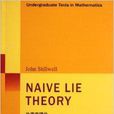基本介紹
- 書名:樸素李理論
- 作者:John Stillwell
- 出版日期:2012年1月1日
- 語種:英語
- ISBN:9787510040597, 7510040590
- 外文名:Naive Lie Theory
- 出版社:世界圖書出版公司
- 頁數:217頁
- 開本:24
- 品牌:世界圖書出版公司北京公司
內容簡介,圖書目錄,
內容簡介
《樸素李理論》是一部介紹李群和李代數的本科生教程,基本的微積分和線性代數知識將對理解《樸素李理論》十分重要。為了讓更多讀者受益,也是《樸素李理論》的最直接目的,書中對經典群核實、復和四元數空間做了較深刻地介紹。書中從矩陣的角度講述對稱群,這樣就可以用微積分和線性代數的基礎理論理解《樸素李理論》中的內容。《樸素李理論》由(美)史迪威著。
圖書目錄
1 Geometry of complex numbers and quaternions
1.1 Rotations of the plane
1.2 Matrix representation of complex numbers
1.3 Quaternions
1.4 Consequences of multiplicative absolute value
1.5 Quaternion representation of space rotations
1.6 Discussion
2 Groups
2.1 Crash course on groups
2.2 Crash course on homomorphisms
2.3 The groups SU(2) and SO(3)
2.4 Isometrics of R'' and reflections
2.5 Rotations of R4 and pairs of quaternions
2.6 Direct products of groups
2.7 The map from SU(2)SU(2) to SO(4)
2.8 Discussion
3 Generalized rotation groups
3.1 Rotations as orthogonal transformations
3.2 The orthogonai and special orthogonal groups
3.3 The unitary groups
3.4 The symplectic groups
3.5 Maximal tori and centers
3.6 Maximal tori in SO(n), U(n), SU(n), Sp(n)
3.7 Centers of SO(n), U(n), SU(n), Sp(n)
3.8 Connectcdness and discreteness
3.9 Discussion
4 The exponential map
4.1 The exponential map onto SO(2)
4.2 The exponential map onto SU(2)
4.3 The tangent space of SU(2)
4.4 The Lie algebra su(2) of SU(2)
4.5 The exponential of a square matrix
4.6 The affine group of the line
4.7 Discussion
5 The tangent space
5.1 Tangent vectors of O(n), U(n), Sp(n)
5.2 The tangent space of SO(n)
5.3 The tangent space of U(n), SU(n), Sp(n)
5.4 Algebraic properties of the tangent space
5.5 Dimension of Lie algebras
5.6 Complexification
5.7 Quaternion Lie algebras
5.8 Discussion
6 Structure of Lie algebras
6.1 Normal subgroups and ideals
6.2 Ideals and homomorphisms
6.3 Classical non-simple Lie algebras
6.4 Simplicity of (n,C) and su(n)
6.5 Simplicity of o(n) for n > 4
6.6 Simplicity of p(n)
6.7 Discussion
7 The matrix logarithm
7.1 Logarithm and exponential
7.2 The exp function on the tangent space
7.3 Limit properties of log and exp
7.4 The log function into the tangentspace
7.5 SO(n), SU(n), and Sp(n) revisited
7.6 The Campbell-Baker-Hausdorff theorem
7.7 Eichler's proof of Campbell-Baker-Hausdorff
7,8 Discussion
8 Topology
8.1 Open and closed sets in Euclidean space
8.2 Closed matrix groups
8.3 Continuous functions
8.4 Compact sets
8.5 Continuous functions and compactness
8.6 Paths and path-connectedness
8.7 Simple connectedness
8.8 Discussion
9 Simply connected Lie groups
9.1 Three groups with tangent space R
9.2 Three groups with the cross-product Lie algebra
9.3 Lie homomorphisms
9.4 Uniform continuity of paths and deformations
9.5 Deforming a path in a sequence of small steps
9.6 Lifting a Lie algebra homomorphism
9.7 Discussion
Bibliography
Index
1.1 Rotations of the plane
1.2 Matrix representation of complex numbers
1.3 Quaternions
1.4 Consequences of multiplicative absolute value
1.5 Quaternion representation of space rotations
1.6 Discussion
2 Groups
2.1 Crash course on groups
2.2 Crash course on homomorphisms
2.3 The groups SU(2) and SO(3)
2.4 Isometrics of R'' and reflections
2.5 Rotations of R4 and pairs of quaternions
2.6 Direct products of groups
2.7 The map from SU(2)SU(2) to SO(4)
2.8 Discussion
3 Generalized rotation groups
3.1 Rotations as orthogonal transformations
3.2 The orthogonai and special orthogonal groups
3.3 The unitary groups
3.4 The symplectic groups
3.5 Maximal tori and centers
3.6 Maximal tori in SO(n), U(n), SU(n), Sp(n)
3.7 Centers of SO(n), U(n), SU(n), Sp(n)
3.8 Connectcdness and discreteness
3.9 Discussion
4 The exponential map
4.1 The exponential map onto SO(2)
4.2 The exponential map onto SU(2)
4.3 The tangent space of SU(2)
4.4 The Lie algebra su(2) of SU(2)
4.5 The exponential of a square matrix
4.6 The affine group of the line
4.7 Discussion
5 The tangent space
5.1 Tangent vectors of O(n), U(n), Sp(n)
5.2 The tangent space of SO(n)
5.3 The tangent space of U(n), SU(n), Sp(n)
5.4 Algebraic properties of the tangent space
5.5 Dimension of Lie algebras
5.6 Complexification
5.7 Quaternion Lie algebras
5.8 Discussion
6 Structure of Lie algebras
6.1 Normal subgroups and ideals
6.2 Ideals and homomorphisms
6.3 Classical non-simple Lie algebras
6.4 Simplicity of (n,C) and su(n)
6.5 Simplicity of o(n) for n > 4
6.6 Simplicity of p(n)
6.7 Discussion
7 The matrix logarithm
7.1 Logarithm and exponential
7.2 The exp function on the tangent space
7.3 Limit properties of log and exp
7.4 The log function into the tangentspace
7.5 SO(n), SU(n), and Sp(n) revisited
7.6 The Campbell-Baker-Hausdorff theorem
7.7 Eichler's proof of Campbell-Baker-Hausdorff
7,8 Discussion
8 Topology
8.1 Open and closed sets in Euclidean space
8.2 Closed matrix groups
8.3 Continuous functions
8.4 Compact sets
8.5 Continuous functions and compactness
8.6 Paths and path-connectedness
8.7 Simple connectedness
8.8 Discussion
9 Simply connected Lie groups
9.1 Three groups with tangent space R
9.2 Three groups with the cross-product Lie algebra
9.3 Lie homomorphisms
9.4 Uniform continuity of paths and deformations
9.5 Deforming a path in a sequence of small steps
9.6 Lifting a Lie algebra homomorphism
9.7 Discussion
Bibliography
Index

